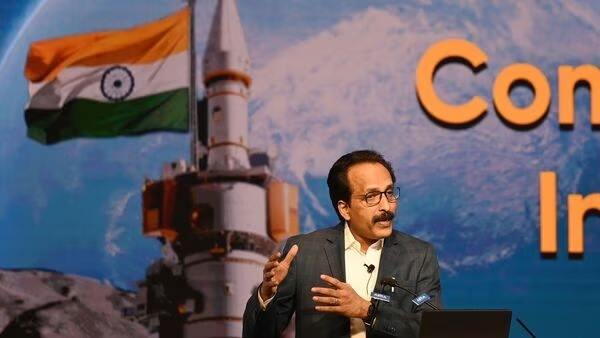11.04.2024
ISRO chief S Somnath discusses India's progress in space exploration, including the upcoming Chandrayaan-4 mission aiming to land an astronaut on the moon by 2040.

ISRO Chairman S. Somnath. Photo by Vipin Kumar/ Hindustan Times) (File)
Indian Space Research Organisation (ISRO) chief S Somnath on Wednesday that the upcoming phase of the Chandrayaan project is in progress, aiming to advance India's lunar exploration efforts.
He indicated that Chandrayaan-4 marks the initial stride towards India's aspiration of landing an astronaut on the moon by 2040.
Addressing a press conference, Somnath said, “Chandrayaan-4 is a concept that we are now developing as a continuation of the Chandrayaan series...our honourable Prime Minister has announced that an Indian will land on the moon in 2040. So, if that has to happen, we have to have continuous moon exploration of various kinds."
Earlier in January, India launched its inaugural dedicated solar mission, the Aditya-L1 spacecraft, positioning it into the Halo orbit around the sun.
Furthermore, the Gaganyaan project stands as another pivotal endeavor for India, aiming to demonstrate human spaceflight capability by sending a crew of three members into a 400 km orbit for a 3-day mission, safely returning them to Earth by landing in Indian waters.
Quelle: mint
----
Update: 14.05.2024
.
Chandrayaan-4's landing site on the Moon revealed
Chandrayaan-4 will be a complex mission involving multiple launches and spacecraft modules. Isro plans to launch two separate rockets – the heavy-lift LVM-3 and the workhorse PSLV – to carry different payloads for the mission.

In Short
- Chandrayaan-4 will have the opportunity to study and potentially retrieve samples
- Chandrayaan-4 will be a complex mission involving multiple launches
- The mission's primary objective is to collect lunar samples
India's ambitious Chandrayaan-4 mission, aimed at bringing back lunar rocks and soils to India, will attempt a landing close to the Shiv Shakti Point on the Moon's surface, according to Nilesh Desai, Director of the Space Applications Centre (SAC).
The information was revealed during a recent presentation by Desai on the Indian Space Research Organisation's (Isro) future lunar exploration plans.
The Shiv Shakti Point, the location of Chandrayaan-3's Vikram lander's touchdown, is a site of significant scientific interest due to its proximity to the Moon's south pole and the presence of permanently shadowed regions that could harbour water ice deposits.

By landing near this area, Chandrayaan-4 will have the opportunity to study and potentially retrieve samples from these scientifically valuable regions. Desai stated that the mission will have an operational life of one lunar day, which is approximately 14 Earth days.
This limited timeframe is due to the harsh conditions on the lunar surface, where extreme temperature variations and lack of sunlight during the lunar night pose significant challenges for long-term operations.
Chandrayaan-4 will be a complex mission involving multiple launches and spacecraft modules. Isro plans to launch two separate rockets – the heavy-lift LVM-3 and the workhorse PSLV – to carry different payloads for the mission.
This approach is a first for Isro and highlights the mission's ambitious nature.
The mission's primary objective is to collect lunar samples and bring them back to Earth for detailed scientific analysis. If successful, India will become the fourth nation to achieve this feat, following the United States, Russia, and China.
Chandrayaan-4 will consist of five spacecraft modules: a propulsion module, a descender module for landing, an ascender module to lift off from the lunar surface, a transfer module to navigate the return journey, and a re-entry module to safely deliver the lunar samples to Earth.
The landing site near Shiv Shakti Point presents unique challenges due to the rugged terrain and steep slopes in the region. Isro will need to employ precise landing techniques and advanced navigation systems to ensure a successful touchdown.
With Chandrayaan-4, India aims to further its lunar exploration program and contribute to the global scientific understanding of the Moon's composition, formation, and potential resources.
Quelle: India Today

